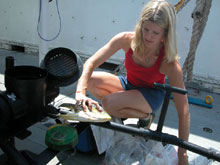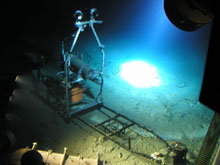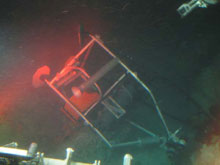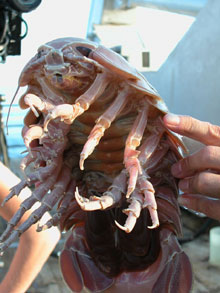
Erika H. Raymond baiting the front of the EITS system (called the CLAM) to draw animals in front of the camera. Click image for larger view.

After the EITS has been deployed, only skeletons remain of the bait. Click image for larger view.
The World According to EITS
September 2, 2005
Erika Heine Raymond
Johns Hopkins University, Baltimore, MD
Ocean Research and Conservation
Association, Ft. Pierce, FL
![]() A Collection Of Images From Deployment Of The Eye-In-The-Sea (EITS) During The Deep Scope 2005 Expedition
A Collection Of Images From Deployment Of The Eye-In-The-Sea (EITS) During The Deep Scope 2005 Expedition
![]() Two Sharks Of An Unidentified Species Bump Into Each Other
Two Sharks Of An Unidentified Species Bump Into Each Other
Yesterday was our first day of submersible operations after hurricane Katrina. The ocean was remarkably calm and from the surface it was difficult to make out any discernible differences from before the hurricane. However, upon closer inspection the changes became apparent. The once azure blue water had taken on a greenish tint and the previously abundant mats of sargassum, a free-floating type of seaweed, had become sparse and tattered. I could only wonder what lay beneath the surface, where we left Eye-in-the-Sea (EITS) one week ago.
Preparing an instrument for deployment into the deep sea is a challenging and exciting task. The deep sea is an incredibly hostile environment void of sunlight with crushing pressures, cold, salty water, and pirates. (OK, so I made up the last part about pirates but it would be fun to claim the treasures of the deep with an Arrr-in-the-Sea.) It is nothing short of a miracle that we can even gather data from these depths. Each recovery feels like Christmas. Gifts from the sea packaged in a shiny gray bottle waiting for us to unwrap them on the surface. After recovery, the images are downloaded from the camera bottle to our laptop on the ship. Inevitably a visual feeding frenzy occurs during these events as the scientists gather around the computer waiting to catch the first glimpse of a giant squid or possibly a new species never seen by human eyes. Often it will take hours to view all of the recordings and the crowd ebbs and flows as new images come in. Only the hardcore remain to watch the entire sequence of clips, willing the giant squid to appear.
Yesterday's ![]() recovery dive for EITS was a success, largely thanks to Tim
Askew Jr.'s superb piloting skills. Typically
considered a blue-water location, with visibility up to 100 feet, visibility
at Vioska Knoll had dropped to a mere 12 feet. EITS was finally found,
upside-down, with its battery knocked out of the rack. With a total
battery life of about 36 hours, EITS had stopped recording several days
before Katrina passed over. Video analysis revealed that the final
recording from EITS was taken while the camera was in an upright position. We
will never know what knocked the system over but feel fortunate to have
it back on the deck of the ship in working order.
recovery dive for EITS was a success, largely thanks to Tim
Askew Jr.'s superb piloting skills. Typically
considered a blue-water location, with visibility up to 100 feet, visibility
at Vioska Knoll had dropped to a mere 12 feet. EITS was finally found,
upside-down, with its battery knocked out of the rack. With a total
battery life of about 36 hours, EITS had stopped recording several days
before Katrina passed over. Video analysis revealed that the final
recording from EITS was taken while the camera was in an upright position. We
will never know what knocked the system over but feel fortunate to have
it back on the deck of the ship in working order.
Images from that last dive exhibited
![]() schools of sharks around the bait,
a large 6-gill shark and my favorite, the charismatic crustacean of the
deep sea, Bathynomis giganteus. Imagine a pill bug the size
of a small dog (like an Italian greyhound) with amazing compound eyes and
gnashing teeth flying through the water in search of deep-sea kibbles.
They are truly amazing creatures.
schools of sharks around the bait,
a large 6-gill shark and my favorite, the charismatic crustacean of the
deep sea, Bathynomis giganteus. Imagine a pill bug the size
of a small dog (like an Italian greyhound) with amazing compound eyes and
gnashing teeth flying through the water in search of deep-sea kibbles.
They are truly amazing creatures.





























